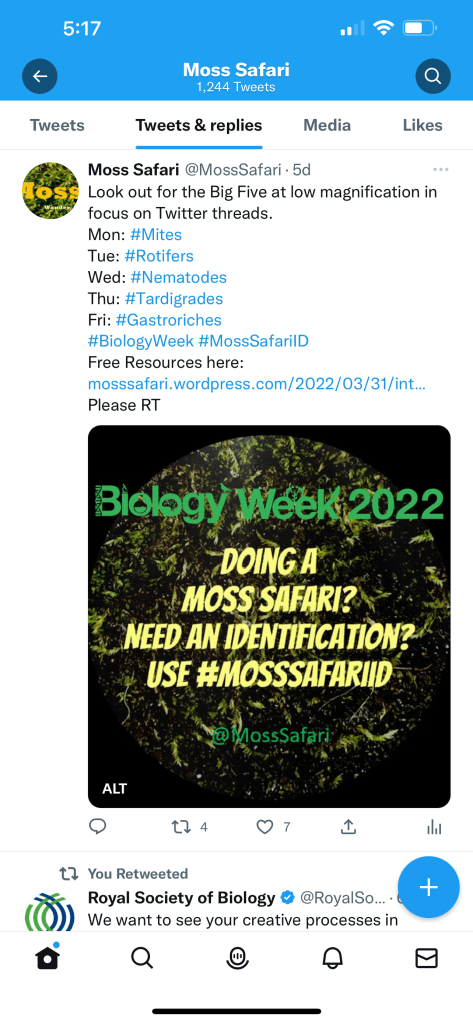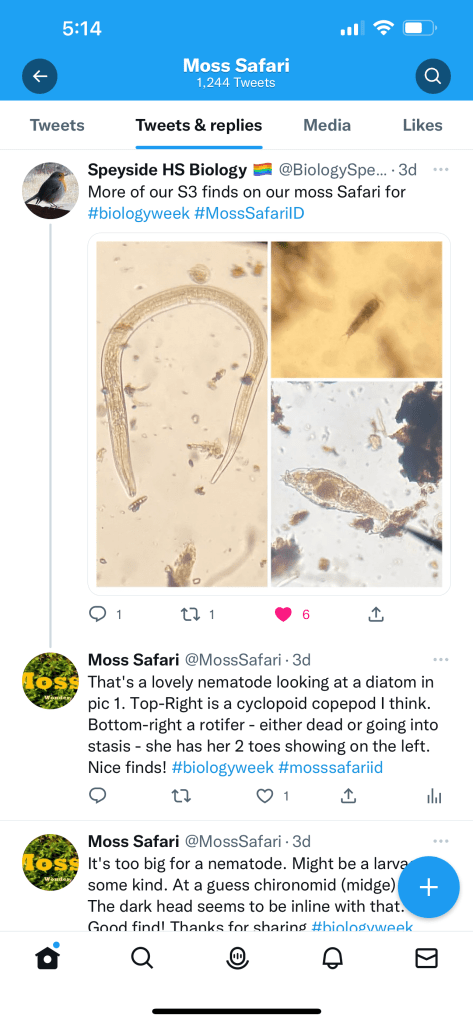The main aims of Moss Safari is to encourage the use of microscopes (particularly in schools) and foster a wonder for the life in moss with the hope that it will lead to children and adults to become amateur or professional scientists. Here is an example of using social media to promote and support engagement with Moss Safari. How could you get involved?
The Royal Society for Biology (RSB) hosts an annual Biology Week (1-9th October 2022) in which the support and host a variety of events to promote biology is schools and to the general public. As a member of the RSB, it felt that it would be good to support the event through using Moss Safari. So, I came up with #MossSafariID as a hashtag along with a high presence on Twitter to support teachers who are doing Moss Safaris to identify any mysterious organisms they that their classes found. A week in advance I promoted the ‘event’ via a blog and postings on social media.
Moss Safari on Twitter
Each day (Monday-Friday) I scheduled three posts. One promoting the focus of the day (one of the ‘Big Five’), one with a link to a blog about the Big Five organism in focus and another (usually with a video of the organism) with links to materials to do your own moss Safari.

I set my Twitter feed searches to the hashtags #MossSafariID and #BiologyWeek and before the week started we had our first inquiry. @KatLawrence sent a video of her find – what I think was a decapitated vorticella.

Once the week off, I had about one enquiry a day from schools doing Moss Safari. A particular bumper find was a chironimid (midge) larvae, nematode, cyclopoid copepod and a rotifer from the school biology department @BiologySpeyside. @DrBrownMGS classes found many nematodes, but experienced their very first tardigrade and shared a video of the cutie wiggling amongst some debris. What a privilege to be part of someone’s first tardigrade find!



For me the best find was the shed skin (exuvae) of a tardigrade containing eight eggs. I was able to link to a blog I had written previously on ‘Tardigrade ghosts’. Pictured below.

This Biology Week gained lots of ‘likes’ and ‘retweets’ and the traffic to the Moss Safari website was up and consistent each day. I saw we passed 500 followers which is more than I ever expected! Though a little way off being an ‘influencer.’

I have learnt that active engagement on social media – making content, sharing ides, encouraging engagement can have a positive impact. No need for me to travel to do Moss Safari’s – just empower teachers and provide ‘online’ support. The power of ‘not knowing’ is part of the joy of science. I will also to continue to build my Facebook Page and Instagram page as well.
Join in
If you are an expert in the types of organisms that live in moss, please feel free to contribute to the #MossSafariID questions. Also, feel free to correct me if I am wrong, I’m no expert and always happy to learn.
Thank you to all the teachers who took part, particularly those who shared their videos and photos and interacted with #MossSafariID. I will keep the hashtag ‘live’ and check it regularly, although I can’t promise immediate responses as I have a proper job as well!
Want to do a Moss Safari? Resources here (scroll to end)
Want me to do an online or live Moss Safari at your school or club, get in touch for availability and pricing.